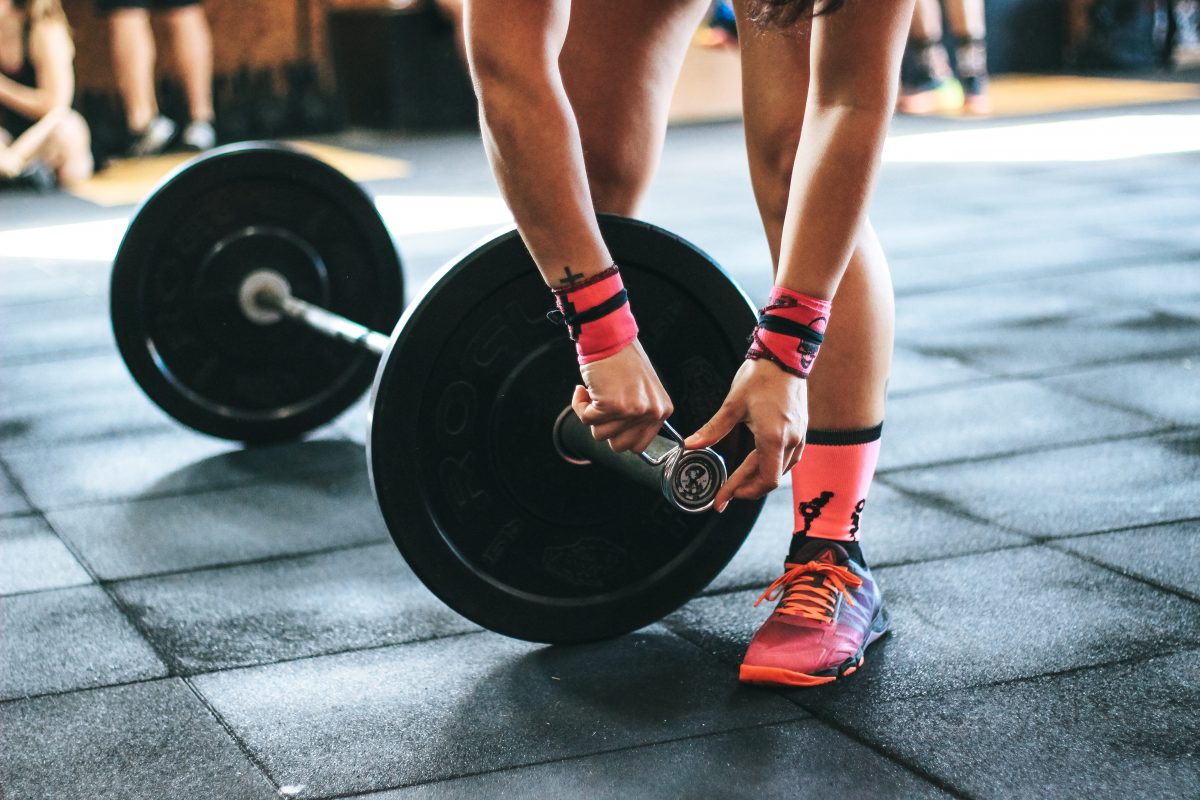There’s a torrential downpour of information being dumped on us. It’s coming 24/7 from all directions. Whether it’s politics or in this case how to get stronger, it’s hard to decipher the signal from the noise.

Nassim Taleb talks about this topic in Antifragile. It’s important for us to be able to sift through all that noise, and to find the signals that we should be paying attention to.
I don’t know if there’s one way to do this. For myself, in terms of how to get stronger, it has mostly happened through trial and error. I suppose as a practitioner, someone who actually does things as opposed to being all talk, there’s no other way to do it. At least as you start out initially on your journey.
Gather information from sources you trust. Try stuff out. Keep what works and toss the rest.
I’ve read it all and tried it all over the years. And while I can’t say I know it all, I’ve definitely filtered out much of the noise and found the signals for how to get stronger.
Those signals have provided the foundation for how I get stronger. I presume they could provide a solid foundation as well for others who are looking for the same.
And like most things, I’ve found what works most often lies in the simplistic solutions; timeless practices that often get overlooked due to their lack of complexity.
As Naval Ravikant says, “ancient problems have ancient solutions.”
And I’d say how to get stronger is a problem as old as man.
Benefits of Being Stronger
Getting stronger is, in my opinion, the holy grail of anti-aging.
We pump our bodies full of chemicals, inject botox into our faces, plump our lips with chemicals, have surgeons suck fat out of our bodies and give them cute names like mommy makeovers, spend an hour each night on our skin routines, spend billions of dollars on supplements that may or may not work (spoiler…most fall under the may not category) all in an effort to age “gracefully,” and look good.
But what most of us fail to do, and what is unquestionably the most beneficial thing we could be doing, is to get stronger.
Build muscle, get stronger. Live life happier.
This…
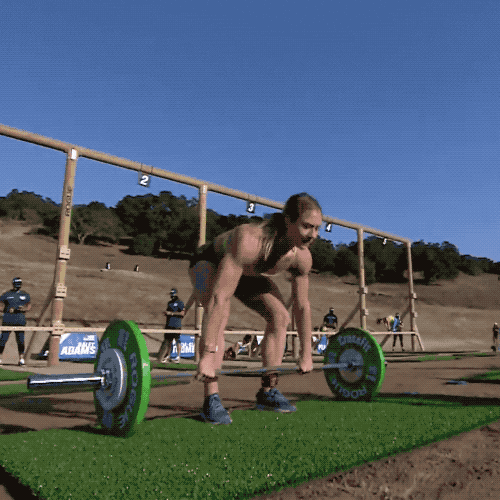
Is better than this…

It’s the one of the best things we can do physically for our long term-health. And it’s not just for the internal stuff like strong bones and increased metabolism. It’s also for the superficial side of things as well, like looking good in a swimsuit.
I mean, do we still want to look good when we’re 40, 50, and beyond? Being strong will have a MUCH greater impact on that than lip injections and skin detoxers. It’s not even close.
As Mark Rippetoe says in Starting Strength, “our strength, more than any other thing we possess, still determines the quality and the quantity of our time here in these bodies.”
We only live once and these bodies are our vehicle for this life. Why not take care of them? We often don’t realize how important they are until they fail us.
If we take care of our bodies they can do amazing things and serve us well. But if we neglect them and let them decline and decay they control us through pain and afflictions.
It doesn’t take long trying to navigate normal, everyday activities with a lower back injury to quickly gain an appreciation for a strong, healthy body.
But this is all abstract. Let’s talk specifics.
Specifically, the benefits of being stronger are:

- Combats Sarcopenia – Sarcopenia is simply muscle loss associated with aging. As a society we seem to have just accepted muscle loss with aging. While this may have some inevitability to it, we can have a profound impact on the rate of muscle loss and keep more of it for much, much longer than we think.
- Sarcopenia (muscle loss with aging) leads to frailty which ultimately increases the likelihood of falls and fractures as we age. The reason it leads to fractures is that without strength training, not only do muscles weaken but so do bones. Bones are antifragile. They require stress to maintain density and strength. With no stress applied, they get brittle and fracture easily.
- Sarcopenia is one of the biggest contributors to age-related decline.
- Gaining and maintaining muscle mass and strength combats sarcopenia! It may not have you looking like you did when you were 20 at age 70, but it can combat the deleterious effects of sarcopenia and keep you looking pretty dang good at any age.
- You generally look better when you are stronger. There are a few factors that physically allow us to be stronger. One of them is larger muscles. And for the most part, the more muscle we have the better we look. Maybe that’s vain, but there’s nothing wrong with taking pride in looking healthy and fit!
- Mental benefits – For me, the stronger I am the better I feel mentally. I’m not sure if there is something physiologically going on where muscles increase our happiness, or if it’s the act of working to get stronger, i.e. exercising and being physically active, that releases endorphins which leads to more happiness. And to be honest, I don’t really care what the cause is. All I know is that throughout my life, as I’ve gotten stronger I’ve noticed a profound positive impact on my mental health.
- You are more Antifragile – If you don’t know about being antifragile, read this. Have you ever heard, “the stronger you are the harder you are to kill.” Generally speaking, I think this is true.
- Muscle mass has been shown to correlate with a decrease in all-cause mortality. That means that more muscle correlates to less risk of dying from a chronic disease than your peers have. It’s also been shown that with more muscle mass one generally recovers from injury and surgery faster.
- It just feels good – walking around feeling strong and fit just feels good!
- Being strong helps you navigate this world better – Need to move some heavy objects around the house, pick up your kids, or pull yourself up off the floor? All of these things benefit from you being stronger. Think about how you interact with your environment on a day-to-day basis and how you move through this life. There’s almost nothing that being stronger wouldn’t help in this regard.
How Our Bodies Get Stronger
Before I dive into the how to get stronger, let’s take a big-picture look at how our bodies get stronger.
Muscles are antifragile. Simply, when stress is applied to them, they get stronger. As Nassim Taleb said in his book Antifragile, “complex systems are weakened, even killed, when deprived of stressors.” This happens to muscles. When they receive no stress, they atrophy.
With that being the case, muscles get stronger through this process:
Stress –> Recover –> Adapt –> Get Stronger
Stress your muscles -> allow proper recovery -> the muscles adapt to that stress-> and they ultimately get stronger.
And remember what I said earlier, simple does not equal easy. The concept is simple. The application can be hard.
How to Get Stronger
1. Progressive Overload
We can lift weights and not get stronger. There has to be some intentionality to it. A process through which the weight lifting or resistance works in making us stronger. That process is through progressive overload.
John Welbourn said it best in his blog that, “progressive overload involves doing more over time.” We are literally overloading our muscles through weightlifting and resistance training and doing it in a way that progresses over time.
Simple.
In a more detailed definition, progressive overload is a deliberate and calculated process whereby you introduce a continual, gradual, and manageable, stress or stimuli on your muscles. It’s a gradual increase in stress on your body over time. i.e. doing more over time.
In the case of how to get stronger, that stressor is resistance training. By resistance training I mean lifting weights or bodyweight training.
More weight. More reps. More Sets. More Volume.
By introducing this stressor to your body, it adapts by getting better at handling that stress. How exactly is it getting better at handling it? Through a number of ways:
-Increased neuromuscular coordination – We simply get better, more coordinated, at the movement.
-Increased bone and muscle mass – Our bones get stronger and our muscles get larger.
-Improvement in Connective Tissue
-Increased lactic acid tolerance
Why is this overloading necessary?
Why do we need to continually increase the stress we are placing on our muscles?
If we don’t continually increase the stress on our body, it will eventually adapt to whatever stress we have put on it. Once we’ve adapted to that stress, if we don’t introduce a new stress, our body would no longer have to get stronger.
We have to constantly keep increasing that stress once adaptation has occurred. Stress the body, body adapts. Stress the body more, body adapts. Stress the body more again, body adapts again. And on and on to get stronger and stronger.
This is progressive overload.
It simply means adding more weight (through more pounds on the barbell, more reps of the lift, or more sets of the lift leading to more total reps) for a specific exercise, like the squat or deadlift, each training session or every few training sessions. Your body adapts to the continued addition of more weight, and gets stronger.
For example, if this week I squatted 100 pounds for 5 reps, and next week I squatted 110 pounds for 5 reps, and the week after I did 120 pounds for 5 reps then I would be progressively overloading and getting stronger.
I’d adapt to 100lbs for 5 reps by getting stronger. I’d then increase the stressor to 110lbs for 5 reps. Eventually my body would adapt to that weight by getting a little stronger than it was. On and on the cycle continues to get stronger and stronger.
Progressive Overload Example
So all together here’s a simplified example of how one would get stronger using Progressive Overload:
- You perform three sets of five reps of squats using 185 pounds.
- You allow ample time for recovery. Ample recovery time varies per individual. An 18-year old would be able to recover faster than a 50-year old would generally.
- During the recovery your muscles adapt to the stress from those 185-pound squats by getting stronger.
- 185 pounds is no longer enough of a stressor on your muscles to cause a new adaptation and subsequent increase in strength so at the next training session you add 10 pounds and now do three sets of five reps of squats using 195 pounds.
- You again allow sufficient recovery during which your muscles adapt to the increased weight, 195 pounds, and get stronger.
- The cycle continues on.
How I Have Used Progressive Overload
From the time I started lifting weights I used progressive overload to get stronger. When I was much younger I used it with bodybuilding-type exercises. I remember curling 20 pounds for 10 reps when I was 14 and being so pumped when I moved up to 25 pounds for 10 reps. I wanted big guns because as my son says now, “curls get the girls!”

Progressive overload is needed to build those guns!
Here are some specific programs I’ve followed using progressive overload:
This program is a pure strength-based program focusing on five key lifts. Those key lifts are the squat, deadlift, press, bench press and power clean. There are only two different workout days (Day 1 and Day 2) and you workout three times per week. One week you do Day 1 twice and Day 2 once, and the next week you do Day 1 once, and Day 2 twice. Each workout you add 5-10 pounds to each lift.
I love the simplicity of this program. As I mentioned earlier, programs have become so complicated. I’ve been doing this stuff for over 25 years and there are some programs I see from “experts” that are so confusing and convoluted that even I don’t know what they mean.
While complexity and nuance are certainly necessary for some programs, primarily amongst advanced or elite-level athletes, for the majority of us simple is best. And this program is simple…but NOT EASY!
One of the best “fitness” resources I have ever come across is the book Starting Strength by Mark Rippetoe and Lon Kilgore that outlined this program.
This book is also the best resource I’ve ever come across that outlines the proper form to (shoulder) press, squat, deadlift and bench press.
Mark Rippetoe breaks down clearly with no BS the proper form to execute each of these lifts.
When I was in the Marines I brought this book with me on a deployment and I ended up loaning it to 5-10 other Marines who wanted to learn how to perform these exercises correctly. One thing about Marines is that they’ll tell you what they really think, good or bad, and they all loved this book.
- Pull Up Progression Program
Pull ups are critical in the Marine Corps. Every Marine has to perform an annual Physical Fitness Test (PFT) consisting of pull ups, sit ups and a 3-mile run. If you can perform 20 dead hang pull ups you max that portion of the test.
For many Marines, this is the hardest part of the test which makes being able to knock out 20 a badge of honor.
I was not a great runner, which may have been a self-fulfilling prophecy because I had somehow drilled this perception into my brain, so I knew the pull ups were an area that I could make up some lost points from my run time. It was my goal to be able to max out the pullups portion of my Marine Corps PFT.
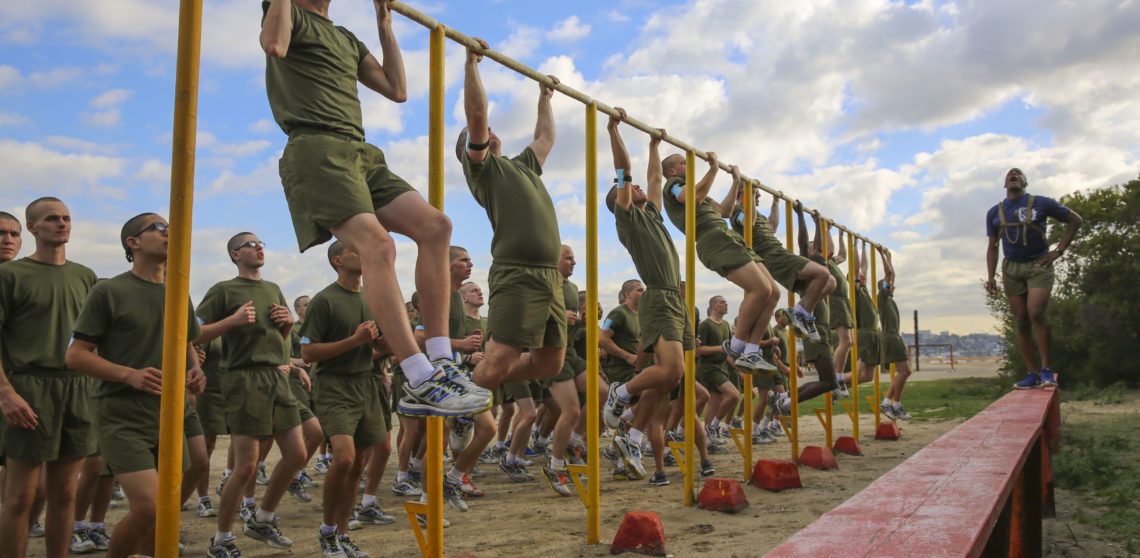
I made pull ups a huge part of my focus prior to my commission in the Marines. One simple plan was performing 5 sets of max reps of bodyweight pull ups multiple times per week.
This was a form of progressive overloading. Instead of adding 5 pounds to a lift, I focused on adding more total reps each pull ups session. The progressive overloading would come in the form of an additional few pull ups per session versus an additional 5 pounds on a bar.
If I was able to do 2 more total reps than the last workout, and at the time I weighed about 170 pounds, then I essentially lifted 340 more pounds than the last training session (170lbs x 2 additional reps= 340).
Here’s what 5 sets of max number of pullups might look like over the course of a few workouts showing progressive overload:
Workout 1 – Set 1: 7 pull ups – Set 2: 7 pull ups – Set 3: 5 pull ups – Set 4: 5 pull ups – Set 5: 4 pull ups Total = 28 pull ups Total Volume = 4,760 lbs (28 reps x 170 lbs body weight)
Workout 2 – Set 1: 8 pull ups – Set 2: 7 pull ups – Set 3: 5 pull ups – Set 4: 5 pull ups – Set 5: 5 pull ups Total = 30 pull ups Total Volume = 5,100 lbs
Workout 3 – Set 1: 8 pull ups – Set 2: 7 pull ups – Set 3: 5 pull ups – Set 4: 5 pull ups – Set 5: 5 pull ups Total = 30 pull ups Total Volume = 5,100 lbs
Workout 4 – Set 1: 9 pull ups – Set 2: 9 pull ups – Set 3: 7 pull ups – Set 4: 5 pull ups – Set 5: 5 pull ups Total = 35 pull ups Total Volume = 5,950 lbs
Over the course of 4 workouts, I increased my total number of pull ups per training session by 7 going from 28 pull ups the first session to 35 the fourth session.
That represented an increase in total training volume of 1,190 lbs from the first training session to the fourth. Basically, on workout 4 I lifted 1,190 pounds MORE than workout 1!
Those additional reps and additional volume represented progressive overload.
This meant my body adapted, got stronger, and I could ultimately pull myself up and over the bar more often.
What Happens when you Plateau, i.e. Can’t Add Any More Weight or Reps?
Obviously, you can’t add weight to the barbell forever. If that was the case, there would be people squatting 5,000 pounds or clean and jerking 1,000 pounds. There are limits to our physical capabilities.
Sometimes the weight just becomes too much.

So what happens when you feel like you can’t add any more weight or reps?
First, ask yourself if you really can’t? There have been many times where I “just wasn’t feeling it that day.” I came back the next time feeling rested and motivated and the weight moved.
Also, understand that you don’t have to add weight to the bar or reps to the workout every single training session for progressive overload to work.
When a brand new lifter starts out they can often easily add weight every training session for a long time. It’s not that they are getting so strong, although getting stronger is one part. They are also learning the lifts and their body is getting better at the technique and they experience a sharp beginner’s growth.
As we get closer to our body’s limits, those gains are slowed down. So if you go a workout or two without being able to add 5 pounds to a squat or deadlift, don’t stress. Keep the weight the same for however many training sessions it takes. And when you finally do complete the prescribed number of reps and weight, with proper form, then move up in weight the next training session.
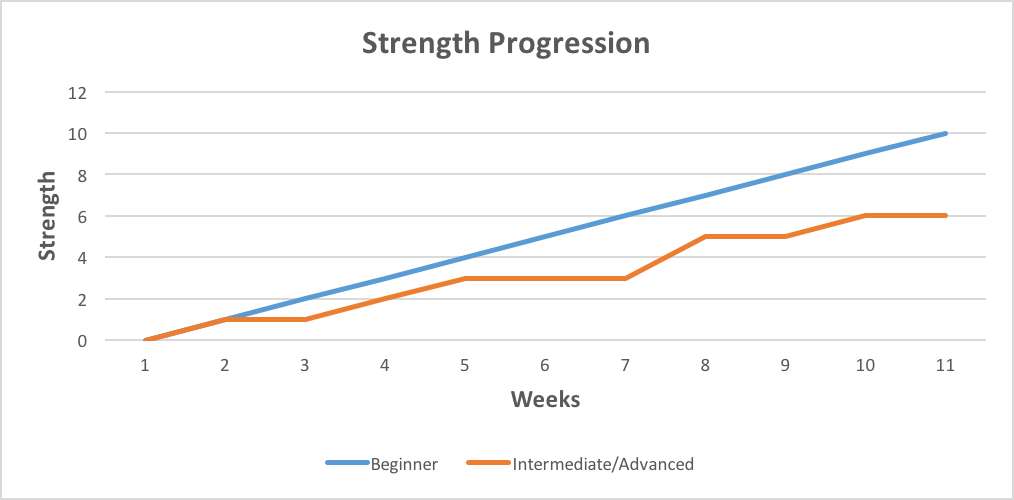
The above graph, which is certainly oversimplified but demonstrates the general point, shows the difference in strength progression in a novice lifter versus an intermediate or advanced lifter using progressive overload. It demonstrates how a beginner lifter often makes more rapid and linear gains than an intermediate/advanced lifter using the progressive overload method.
An intermediate/advanced lifter has ups and downs, stalls some weeks, gets stuck at the same weight at times, but over the course of time still gets stronger; albeit at a lesser pace than a novice.
In the end, both lines on the graph represent getting stronger using progressive overload.
There have been times where I’ve been stuck for a month at the same weight before I finally got over the hump and was able to go up. Sometimes I go up in weight and complete the prescribed reps only to fail to get as many reps the next session with the same weight.
Sometimes if I’m stuck too long I’ll try adding just one more rep or one more set with the same weight so I’m doing progressive overload in a different element than just adding more weight to the bar.
As you get stronger and stronger, and become a more advanced lifter, your methods for progressive overloading may need to become a bit more complex than just adding 5 lbs to the bar or an additional rep.
But even in those more complex programs, progressive overload is still an underlying principle forming the foundation. And for most folks, this level of complexity is not necessary. There are plenty of ways to use progressive overload in a simplistic fashion.
To this day, after over 25 years of lifting weights, progressive overload still forms the foundation for most of my strength training.
2. Volume
Volume seems to be the main driver of hypertrophy (increase and growth of muscle cells), not rep ranges. Meaning, whether you do 3 sets of 10 or 5 sets of 6, what matters most is the total volume of work and not the rep ranges (sets of 10 versus sets of 6).
Volume = Weight x Reps x Sets
For example, if I lifted 135 lbs for 5 reps and 3 sets the total volume would be: 135 x 5 x 3 = 2,025 lbs.
Volume is essentially a component of progressive overload. When we progressively overload we add more weight to the bar, or add more reps, or add more total sets. Doing this increases the total volume of work.
As long as the volume is enough you can get stronger in all different rep ranges. Power lifters often lift in very low rep ranges. Anywhere from 1 to maybe 5 reps whereas you’ll see bodybuilders often lifting in the 8-15 rep range. (There are obviously power lifters who might lift with more reps than 5 and bodybuilders that might lift in lower reps than 8 but mostly they seem to stick to these rep ranges) Both are getting stronger as long as the volume is enough to elicit a stimulus calling for their muscles to adapt.
How do you know how much volume is enough to elicit this adaptation?
First you have to focus on intensity. I’ve always wanted to feel like I am pushing close to failure, but not exactly going to failure. That means I’m really pushing and struggling those last few reps but finish with maybe a rep or two in the tank versus finishing when I literally can’t lift anymore and the weight just crashes down on me.
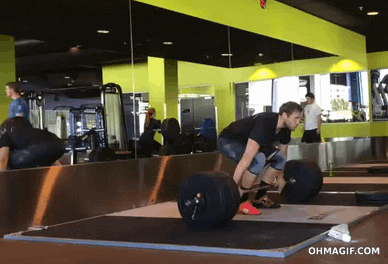
Total sets is another component of the volume equation. The general consensus seems to be that around 10-20 sets per body part per week is enough to continue to make progress and get stronger.
For beginner lifters, sticking closer to 10 sets will most likely be enough while for more advanced lifters they’ll want to be closer to 20 sets per week.
Putting Volume Together
In practice, it might look like this:
Let’s focus on legs and see how I think about volume over a week to get them stronger.
I’m going to aim for around 18-20 sets of leg work over a week long period. For me, that’s too many sets for me to do in one workout so I’d split those 18-20 sets over two workouts for my legs.
The first leg work out of the week would look like this:
Squats – 4 sets of 6-8 repetitions using 235lbs (last week I was able to get 8 reps for all 4 sets using 230lbs so in the spirit of progressive overload, I added 5 pounds to the bar this week in an effort to provide enough stimuli to create an adaptation for my leg muscles to continue to get stronger) 4 TOTAL SETS
Split Squats – 2 sets of 20 repetitions each leg holding (40lb dumbbells) – This is higher reps than I’d normally perform but 40lb dumbbells are the heaviest I have in my garage gym. In a perfect world I’d probably grab 50lb or 60lb dumbbells and do 10-12 reps each leg. 2 TOTAL SETS
Romanian Deadlifts – 4 sets of 10-12 reps using 225lbs 4 TOTAL SETS
All in all, I would have performed 10 total sets of leg exercises. My total volume would look like this (Remember: Volume = Weight x Reps x Sets):
Squats (let’s assume I was able to complete 8 reps for all 4 sets)
235lbs x 8 x 4 = 7,520 lbs total volume on squats
Split Squats
40lbs x 20 x 2 = 1,600lbs volume per leg for split squats
Romanian Deadlifts (lets assume I completed 12 reps for all 4 sets)
225 x 12 x 4 = 10,800lbs total volume on romanian deadlifts
Overall, my total volume was 21,520 lbs (I counted 1,600 twice – once for each leg) for this leg workout. I completed 10 total sets.
To get to 18-20 total sets for the week to get my legs stronger, I’d do one more leg workout that would look somewhat similar to this one and would have 8-10 total sets.
Next week, when completing this workout again, I’d aim to add a few pounds to each of these lifts (progressive overloading principle). If I completed this same amount of total sets and repetitions with more weight on the bar, I will have created a new stress on my muscles that they’d have to adapt to.
I would continue to increase my volume week after week (again, progressive overload) and I’d get stronger!
3. Eat Enough Protein
Proteins are the building blocks of our muscle.
There are two opposing processes that occur in regards to protein and muscles in our bodies. They are muscle protein synthesis and muscle protein breakdown.
Per Layne Norton in his video, Calories IN Calories OUT: What’s all the confusion about?, “muscle protein synthesis is a naturally occurring process in which protein is produced to repair muscle damage caused by intense exercise. It is an opposing force to muscle protein breakdown in which protein is lost as a result of exercise. If MPS outpaces MPB, muscle growth is achieved.”
MPS is the process of building muscle proteins.
The blog Nutrition Tactics, uses a great analogy. It says to think of our muscles as brick walls. “Each brick is an amino acid. Muscle Protein Synthesis is the addition of new bricks to the wall.”
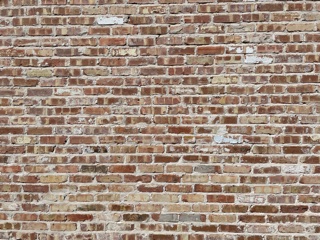
MPS and MPB are always happening in our bodies. We can’t stop one or the other completely, but we can impact their increase or decrease.
If we want to be getting stronger and building muscle, we need to ensure our MPS outpaces our MPB. So how can we increase our rate of MPS?
Resistance training is one way to increase our MPS. If we follow a progressive overload principle and work with the sufficient amount of volume and intensity as outlined above, we will be increasing our MPS.
The second thing we can do is to make sure we are eating enough, and the right kind, of protein.
How much is the right amount?
I’ve always strived for around 1 gram of protein per pound of bodyweight. I usually fluctuate around 168 pounds so I usually aim for 160-170 grams of protein per day. Some days I go under and others I might go over. But I’m usually around that 160-170 grams/day mark.
The source of protein is also important. Not all proteins are created equal in terms of their capacity to stimulate MPS. The digestion rate and amino acid profile are the main drivers that determine the effect of protein.
Animal-based protein sources have a high and complete amino acid profile which is why they are generally superior at driving MPS and ultimately muscle growth.
To be clear, I know it is possible to build a strong body without animal protein, but I have no experience doing so and it takes a lot more intentionality and planning than consuming animal proteins.
And let’s be real, animal protein is dang tasty!

I for one have always gotten the bulk of my protein from animal sources such as beef, chicken, pork, eggs, fish and whey protein.
There does seem to be an upper limit when eating protein in one sitting as to how much goes towards increasing MPS and ultimately being used to build muscle.
Any amount of protein over 40-50 grams eaten at one meal is no longer going towards building muscle. It’s not to say you can’t eat more than that at once. And it’s not to say your body will have trouble digesting more than that at once. It’s just that it won’t have much impact on your muscle growth above that amount.
That’s why I’ve always eaten 4-5 meals and snacks per day so I could spread out my protein intake over many meals and optimize the protein I’m eating to all go towards muscle repair and growth, i.e. muscle protein synthesis.
A typical day of eating in terms of protein for me might look like:
Breakfast – 4 eggs (around 30 grams of protein)
Lunch – Chicken thighs (around 35 grams of protein)
Mid-Afternoon Snack – Sardines (around 20 grams of protein)
Protein Shake – (Around 30 grams of protein)
Dinner – Steak (Around 40 grams of protein)
That comes in around 155 total grams of protein from animal sources. Some of the other food I eat has protein as well. While those sources may not consist of complete amino acid profiles like animal protein, because I am eating them in conjunction with the animal proteins and these animal proteins are providing the bulk of my daily protein, they are enough to put me over that 160-170 total grams per day I’m aiming for.
4. Do the Big Lifts First
The foundation of my strength program has always been centered on the big lifts. They are the squat, deadlift, press (shoulder press as it’s more commonly known), and bench press.
These lifts are known as compound lifts. Compound lifts are multi-joint exercises that generally involve the whole body. A bicep curl includes only the elbow joint and is thus not a compound lift. However, a squat involves the hip, knee and ankle joints, hence it is multi-joint and considered a compound lift.

Why should a good strength program have these lifts as the foundation?
They give you the biggest bang for your buck. They allow you to lift the most weight which allows you to get the strongest overall.
This goes back to the volume concept. The more volume, the stronger we become.
Let’s compare two lifts and look once again at the bicep curl and squat.
Obviously our legs are much stronger than our biceps. I can easily squat 225lbs for 10 reps but I could probably only curl around 125lbs for the same 10 reps.
That means my volume for the squat in this example would be (225 x 10 = 2,250lbs) while my volume for the bicep curls would be (125 x 10 = 1,250lbs).
That’s 1,000lbs MORE volume on the squat versus the biceps curl for the same amount of 10 reps. If I did each set three times that’d be 3,000lbs more volume squatting than bicep curling!
To be fair, the squats are a hell of a lot harder than the bicep curls. But in the gym, the harder it is can often be correlated to how impactful it is. And the big lifts are HARD and thus IMPACTFUL!
This ability to lift more weight is one of the primary reasons I always start my strength workouts with one of these big lifts. Also, they are the most taxing on the body so I like to perform them when I am the freshest and not worn down from other exercises.
To me they are the most important; the highest priority. Because of that I do them first when I have the most effort to give them.
I do want to be clear that you can still get stronger from lifts that I don’t call the big lifts. Doing bicep curls and employing the progressive overload principle to them will absolutely get your biceps stronger over time. You just won’t get the kind of full-body strength that you’d get from those big lifts like the squat, deadlift, press, and bench press.
But those accessory lifts like bicep curls, lunges, pull ups, etc., certainly have a place in a good strength program. If you remember above I spoke about how one should aim for 10-20 sets per week to strengthen a specific body part. These big lifts are so taxing that it isn’t prudent to spend all 10-20 sets just on each big lift per body part. For instance, I personally would not perform 15 sets of squats on a day where I’m focusing on my legs.
This is where the accessory lifts come into play. I may do 3-5 sets of squats, my big lift for the day, and use the remaining 5-7 sets needed on accessory leg exercises like Romanian deadlifts, lunges, even hip thrusts when I’m trying to get my booty poppin’!
For years I’ve started out a back workout with deadlifts and followed with pull ups (the second most taxing back exercise for me) and followed those with different rowing variations.
Even when I’m not doing traditional bodybuilding-style workouts where I focus on specific body parts I still prioritize the big, compound lifts in my workouts.
For example, on a day where I’m wanting to do some metabolic conditioning in the form of a CrossFit workout, I’ll usually start with some sort of compound lift and follow it up with a WOD.
An example one of these days might consist of me starting with squats for 5 reps across 5 sets. Afterwards I might then do a WOD like Helen (3 rounds of time of a 400m run, 21 kb swings, 12 pull ups).
With big reward, comes some bigger risks. And there is probably a bigger risk of injury when doing these big lifts based on the sheer fact that you are handling more weight. The lifts in themselves are very safe when done properly. But with all that weight, it’s often tempting to cheat a little or push a little too hard at the expense of the proper form.
That’s why form is so important when doing the big lifts. Not only is proper form more efficient allowing you to lift more but it also allows you to lift the weight safely.
Don’t be a gym hero and try squatting or deadlifting 400lbs with poor form to impress your buddies. I’ve been there, done that and it’s NEVER worth it. Better to do half that amount with proper form.
That’s why it’s important to find a good gym, trainer, or resource when learning how to perform these lifts. One of the best resources I’ve found over the years on how to use proper form is Starting Strength by Mark Rippetoe.
There’s one last caveat when it comes to the big lifts I’ve described here. I struggle with whether to add in this caveat because sometimes too much nuance just muddies things up. But I’m going to do it anyway because there are definitely dudes out there harping on this topic.
You do not have to do these big lifts to get stronger. Some people might not be able to do them due to some form of injury or pre-existing condition. Some folks may just not want to do them.
For years when I was young I didn’t know how to squat properly so my big lift for legs was the leg press. And I was able to get stronger. But the principle of doing the big lifts first still applied as I always started my leg workouts with the leg press.
But personally, and I write about what I’ve found works from personal experience, while you can get stronger without squatting, deadlifting, bench pressing and shoulder pressing, I have not been able to get as strong without those lifts and if I tried to it’d probably take more time in the gym to make up for how efficient these lifts are at getting me stronger.
These specific big lifts not only get me stronger but they do it more efficiently than when I’ve subbed other exercises for them.
So do the big lifts and do them first and follow them up with the accessory lifts and movements to get you to that 10-20 total set range as discussed in section 2 on volume.
5. Rest/Sleep
I think there’s starting to be a shift in society away from the idea that sleep is not important. In fact, it seemed for most my life people bragged about the lack of sleep they got. It was almost a badge of honor to say how little sleep one could survive on.
But survive is not the same as thrive. And you’ll never be as strong, or healthy for that matter, as you could be if you don’t prioritize sleep.
Besides why wouldn’t you want to? Don’t we all LOVE sleep?!?!?
And 99% of the time it’s not life and death situations that are keeping us from sleep. It’s wasted time. It’s sitting in front of the television, or scrolling through social media in bed, or sitting on the couch drinking alcohol in a haze.
I’m not going to lie, one of the best parts about school starting for our kids is that they have to go to bed early on school nights and that means my wife and I are in bed pretty much right after them.
Whereas I used to brag about how little sleep I got, I now love to talk about how early I go to bed. Maybe that’s just part of getting older. Maybe that’ll be on the next insurance commercial about turning into your parents. Don’t old people love to talk about what time they went to bed?

But going to sleep doesn’t just happen. Here are the things I’ve done over the years to help me fall asleep quickly and get a pretty good night’s sleep most of the time.
1. Get sunlight in your eyes first thing in the morning
This is a new one for me. And to clarify, I don’t mean stare at the sun in the morning. What I mean is to get outside early and get some sunshine on your face without sunglasses.
I learned about the importance of sunlight in the morning from Andrew Huberman. He made a post on instagram on this topic and also mentioned it on Mark Bell’s podcast, Power Project.
To grossly simplify, getting sunlight in the morning signals to our body that it’s time to wake up and around 16 hours later it’ll be time to go to sleep. The rising and setting of the sun is what signals to our body what time of day it is.
Getting sunlight in the morning essentially helps set our circadian rhythms.

What I’ve been doing lately, when my work schedule allows, is going on a 15-20 minute walk within an hour of waking up. Not only does this get me the morning sunlight I need, but it also gets me moving and out in nature first thing in the morning which I’m finding is a great way to start my day. It just puts me in a good mood!
I grossly simplified above what getting sunlight in the morning does for us. And as I mention often, I’m not too concerned many times with why something works. I just like to try it out and if it works keep it as a tool for me.
But I found this so interesting that you might too. If you want to get in the weeds a little more on this topic check this out.
2. Unwind later in the evening
I usually try to keep things pretty calm after dinner. With kids and crazy sports schedules this is easier said than done. The goal is to try and start winding down and not be too worked up when I get in bed. I never work out late at night for this reason. But if that was the only time I could work out, I’d choose to do it as opposed to not doing it.
3. Don’t drink too much fluids before bed
The more we drink the more we have to use the restroom. The older I get the more I have to do it anyway so I definitely don’t want to add a bunch of fluids to my system at night so I wake up a bunch of times throughout the night.
4. Don’t drink alcohol
There’s no question that alcohol has a significant impact on my sleep. It seems to be pretty well known that that’s the case. In fact, I’m sure I could link to a bunch of studies showing this. But I don’t need studies to know the impact it has on me.
My wife and I used to spend our time in the evening unwinding on the couch watching tv and drinking wine. This was our routine for years. It wasn’t until we stopped this for a significant amount of time that I realized what impact this had on my sleep.
Just having 2-3 glasses of wine had a large negative impact on how well I slept. I knew drinking “too much” had an impact, but I didn’t realize that just a few glasses did as well. I sleep so much better when I haven’t had any alcohol; even just a couple glasses of wine or beers.
I still drink alcohol, but for the most part, I save it for the weekends. It’s easier to take the hit in quality of sleep when I’m not having to get up as early as I do on the weekdays.
Maybe this is me getting old and lame, but I love falling asleep quickly and feeling so refreshed in the morning.
Sleep is critical for our immune systems and our body’s ability to recover. Both of these are necessary for how to get stronger. And for me, and I’d guess most folks, this is one of those things where we can easily love the process. I mean, if the process, i.e. the “grind,” is getting lots of sleep, isn’t that something we can all get on board with?
5. No TV in bed
This is probably one of the biggest points of contention between my wife and myself. She wants a tv in our bedroom and I refuse. For me, a bedroom is for sleeping and should be set up as that type of environment. Just like drinking alcohol impacts quality of sleep, I’m sure there are many studies proving watching television in bed does the same. Whether it’s the impact from the light of the tv or something else, something about it impacts the quality of sleep.
In marriage you pick and choose your battles…this might be one I take to the end!
6. No Social Media/Cell Phones in Bed
As great as our phones are, I often wonder if the net negative effect is greater than the net positive. Just like the light from television can impact our quality of sleep, so too can the light from our phones. This would be reason enough to avoid using them in bed.
But an even bigger reason is the allure of social media. Social media is designed to be addicting. We know that’s true. How often have we sat there scrolling and scrolling only to realize we are in a trance? It’s hard to put down the phone when on social media and even more so, it’s hard to turn off our brains.
Especially in these hyper-partisan times when we’re almost looking to get riled up when we’re on Facebook or Twitter or whatever else. It’s probably never healthy no matter the time of day, but it’s ABSOLUTELY not healthy right before going to sleep.
Getting riled up before shutting your eyes in bed is not conducive to getting a good night’s sleep. In fact, I can’t think of anything much worse for that.
And full transparency, I struggle sometimes with this one. For the most part I never look at my phone when I get in bed. But sometimes the call is just too strong. I’ll just pick it up for a second I tell myself. A second turns into a minute which turns into a ton of minutes. Next thing I know I’m worked up over God-knows-what and kicking myself for picking my phone up in the first place.
If I was smart I’d plug it in away from my bed. But I still use it as my alarm. I should probably invest in an actual alarm clock soon so I can keep the phone away from the bed.
7. Read in bed
So if I don’t watch television or look at my phone in bed, what do I do.
I read!

Through high school and college I never read for fun. But I remember being a few years out of college thinking to myself, “I should probably start reading so I don’t just absolutely give up on learning anything for the rest of my life.”
I’m so happy I did. Reading has turned out to be one of the best things I could ever imagine for a number of reasons. One of them just happens to be that it’s something I can do before bed for enjoyment that also puts my mind in a place where it can shut off and allow me to fall asleep quickly.
Because I want to turn my brain off at night I’ll usually read what I call mindless entertainment in bed. I save the deep, insightful reading for other times of the day. Before bed it’s spy thrillers, courtroom dramas, and other great forms of storytelling.
Outside of the occasional time when I get so into a story I can’t put it down, for the most part these books put my mind right where it needs to be before turning off the light and shutting my eyes. In fact, they usually do such a good job that I often have to reread the last few pages from the night before because I was so tired at that point I don’t remember what they were about.
A stack of books on my bedside table is a staple for me. I never let that stack get down to zero because I have to read to fall asleep and I don’t ever want to finish one book and not have another to start.
For the rest of my life I know one constant will be this stack of books next to my bed.
8. Keep it dark and cool
There’s something to be said for an environment matching it’s purpose. It should match it’s function. An office that feels like an office makes us want to work. A library that feels like a real library makes us want to read. The same can be said for a bedroom.
A bedroom’s function is to provide a place to sleep. It’s not an entertainment center, which is another reason I don’t want a tv in it.
A dark and cool room is conducive to sleeping. It’s that simple. That’s why I keep my room dark and cool. At least, I keep it as cool as the Texas weather will allow me to.
I think I read that 68 degrees is the optimal sleeping temperature. At the apex of the Texas summers, when it’s still 90 degrees at night, even with my AC pumping full blast it can’t cool my room to 68. When that happens I get the fan going full blast and substitute the comforter for just a sheet.
There are beds that have cooling functions built into them now. You can literally set the bed to a temperature and the mattress will cool to that setting. I’ve never tried one but it’s definitely on my list of things I’d like to get someday.
In the end, setting up my bedroom as a place for sleeping and specifically keeping it dark and cool has helped me recognize it as a place to sleep, not stay awake.
9. Be tired!
I know this sounds obvious, but it sure is a lot easier to go to sleep when you’re tired. That’s a big reason I don’t sleep in super late anymore on the weekends. Well, having kids makes that difficult too. But they’re old enough now that I could stay in bed until 10am on a Saturday and they probably wouldn’t even notice. They’d be on their ipads or Xbox playing games with their friends.
So I always try to get up relatively early so I’ll be tired at night. On the weekdays that’s easy because I have to get up around 6 to start getting the kids ready for school. Because of that I usually get up around 5:30 so I can have some time to drink some coffee and read and relax before the chaos of the day begins.
That morning sunlight I spoke about earlier also helps me be tired at night because my body’s internal clock knows it’s time to for sleep.
Being physically active throughout the day also helps to be tired at night. If you’re following the principles outlined above on progressive overload and lifting with volume that is close to failure and doing the big lifts, chances are you’ll be exhausted at night.
Not only do I try to be physically active from a viewpoint of getting stronger, but I also like to be physically active for other reasons. I’m constantly playing sports with my kids to bond with them and help them get better. And I love to go for walks.
In regards to walks, I don’t use them as exercise. I like to walk slowly just to collect my thoughts and get outside in nature. Because of that I never listen to music when I’m on a walk.
Between getting up early and getting sunlight right away, lifting weights, playing with my kids, and going on walks, I exert enough physical energy that when I turn off the lights at night and close my eyes my body is physically tired and in need of sleep and recovery.
This allows my body to get the rest it needs to fully recover, adapt, and get stronger. AKA…get my beauty sleep.
6. Have a Plan and Track it
For progressive overload to work, you actually have to progressively overload. And you have to do it consistently. So that requires a plan and it requires keeping track of that plan.
I can’t tell you how many times over the years I’ve thought to myself, “I’m going to start saving more money.” But I never actually say HOW I’m going to do that. I just tell myself vague statements like, “I’ll spend a little bit less on Amazon, stop going out to eat as much, and just keep an eye on my spending closer.” And guess what? That NEVER works.
That is little more than wishful thinking.
How have I been able to save money? I have a plan and track it!
Instead of, “I’ll spend a little bit less on Amazon,” my plan says, “I will only make one purchase from Amazon per week and it will be on Sunday.” That stops me from all the impulsive purchases Amazon has made so easy to do.
Amazon has made it almost too easy on us. They know the easier they make things, the more we’ll buy. Of course they’re RIGHT! Any random thing that pops into my mind I think, “I’ll just order it on Amazon and it’ll be here tomorrow.” Hell, there’s a good chance it might be here tonight.
As the great comedian Ronny Chieng said, pretty soon we’ll want Amazon Now. We’ll complain if it takes 2 hours to get us what we want.
So instead of making multiple purchases on Amazon throughout the week, my plan only allows one time to purchase what I need weekly. Come Sunday, I know I only have one shot to order what I need from Amazon. My wife and I talk it out and through this, we generally don’t make all those impulsive, spur-of-the-moment purchases I make like when I’m just ordering anytime I get the impulse.
In the end, this plan helps us just get what we need, not what we want, and ultimately we spend less per month on Amazon.
Another example would be instead of saying, “I’ll stop going out to eat as much to save money,” my plan might include, “$200 per month going out to eat (with 3 kids it’s hard to get out of Chick-Fil-A for under $50!!!!).”
And instead of saying I’ll, “just keep an eye on my spending more,” my plan would include, “a weekly budget meeting with my wife to discuss the prior week’s spending, next week’s spending obligations, and any future big spending items we need to plan for.”
When my plan is specific and trackable I get results. When it’s vague and full of statements that can’t be tracked, I don’t get results.
The same goes for getting stronger!
Every few months I’ll write out a broad, general plan for the next few months. It will include statements like, “focus for the next 8 week cycle will be on increasing squat strength and metabolic conditioning.” That’s the macro focus.
The micro focus is what is detailed and trackable. I write the specific workouts every Sunday or Monday for that week’s workouts.
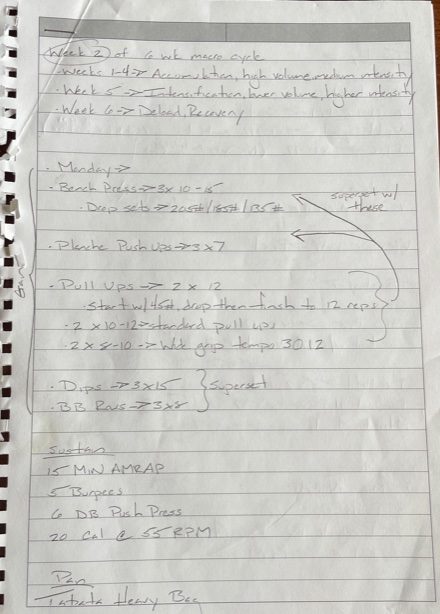

These weekly plans include the exercises I’ll be doing, how many reps I’ll be doing (within a range) and the weights I’ll be doing as well. Then as I do the actual workouts I track exactly what I’ve done. Then I use those numbers to help plan for the following week.
I track all sorts of things. You can see from one of my logs above I even sometimes log how I feel. One of these days I must have had a sore back because I wrote a note about it and adjusted the workout to accommodate it. (Sidenote, 10 years ago I would have fought through the back pain…I’ve thankfully learned to finally listen to my body now)
For instance, if I write that I’m going to do five sets of squats on Thursday of this week with 250 pounds for five reps each on my plan it would be written as; Squats (250#) – 5 x 5. Come Thursday, if I complete all 5 sets with 5 reps I’ll mark that on my plan and maybe even make a note telling myself to go up 5 pounds next week. Then when I sit down to plan for the next week’s workout I’d plan for 5 sets of squats at 255 pounds this week as opposed to the 250 pounds from last week.
Progressive overload in action.
If we want to make progress in something we need to be specific and we need to track it so we ensure we are actually making progress. Saying you want to get stronger but walking into the gym with no plan will not work. Just like saying you want to save money with no plan won’t work either.
So have a plan and track it!
7. Create Habits and Be Consistent
Mark Bell posted something recently that I found very compelling. He said the best science is consistency. You can have the best plan and the best resources and all the best intentions, but if you’re not consistent you won’t get results.
Getting stronger, unfortunately, is not an overnight matter. It takes time and consistency. It takes the grind of day after day, week after week, month after month, and year after year of doing the right practices, many of them explained above, over and over and over.
It can all seem daunting. For many it is so daunting it keeps them from doing it.
I also understand that reading this post makes it seem like there are SO MANY protocols to getting stronger. “It’s just too much,” we can think and throw our arms up in surrender.
But many things can seem daunting when only focusing on the end point. In order to keep healthy teeth you have to brush twice a day, floss once a day, go to the dentist every 6 months and you must do this FOR YOUR ENTIRE LIFE!!!! “Wow, that is just too much!” Nobody ever really says that right? They just do it. So how come that doesn’t seem daunting?
Simple, it’s a habit. So we just do it.
There’s a misperception that habits and routines confine us. They lock us up. But it’s the opposite. Routine and habits FREE US! They prevent every single daily decision from being this big, mentally exhausting exercise. Can you imagine how painful it’d be if every single time we went to brush our teeth we had to muster up the will power and motivation to do so?
If everything were that hard we would not be free. We would be beholden to all our obligations and things we need and should do.
Habits and routines free up our mental energy so we can focus on other areas of our life. Instead of mentally expending energy everyday to brush our teeth the habit of just doing it frees up this mental energy to tackle something more complex, unique, and interesting.
As the great Jocko Willink says, “discipline equals freedom.”
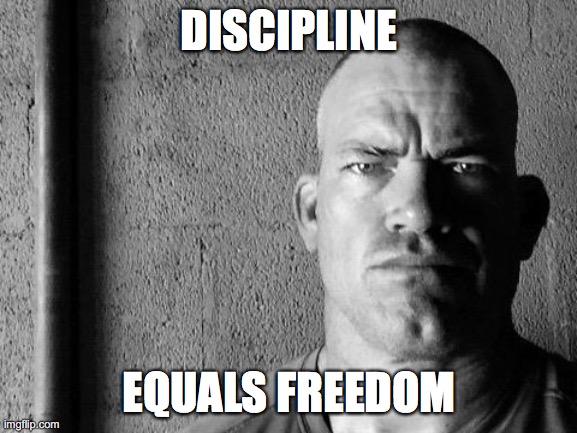
Believe it or not, getting stronger can be the same way. If we develop the correct habits, again, those mentioned above, it doesn’t seem so daunting. It just becomes something we do.
And if it’s something we just do, then those days, months, and years just start adding up and the consistency takes care of itself. And once you start seeing results it can make the habit easier and easier to do because you become more and more ingrained in the process.
It becomes part of who you are.
There’s a lot of things we can do to make exercise a habit. I wrote about it here.
In the end, despite all the fancy gimmicks out there, and all the snake-oil salesman selling solutions that are too good to be true, just know that to get stronger it takes simplicity, and consistency. Do the right actions, and do them over and over and the results take care of themselves.
A funny thing happens when it comes to getting stronger, the habits that make us stronger, as written about throughout this post, become enjoyable in and of themselves, independent of the ultimate outcome of being stronger. You ultimately love the process because those activities make you feel so good on a day-to-day basis.
As Shane Parrish says on his great blog, fs blog, “what’s worthy of pursuit cannot be accomplished in a hurry.”
And I’d say that being stronger is certainly a worthy pursuit.
Be consistent with the right habits.
8. Stick to the Basics
Speaking of simplicity, that’s the focus of this last point. I’ve been trying to get stronger now since I was 14 years old. It started like a lot of folks. I wanted big muscles to look good! While that has not necessarily changed, the focus has definitely shifted to having a better quality of life and hopefully a longer life as well.
In those 25+ years of working to get stronger, the basics have formed the foundation of my efforts. Resistance training, progressive overload, and consistency.
Over the years my wife has asked me to write workout programs for her. Like lots of folks, she’ll stick to them for a few months but then life will get in the way.
A few years ago she asked me again to write her a program. I wrote it out and handed it to her and she said, “that’s the same thing you had me do last time.” I said, “I know. It was the right program last time and it’s the right one this time.”
People seem to want change just for the sake of change. They don’t often give the tried-and-true basics a long enough chance to even work. And maybe that’s not their fault. With companies and influencers peddling false promises of get-fit-FAST products it’s easy to understand why many people can be seduced by these promises and gimmicks.
In the great book, Atomic Habits, James Clear says:
“The greatest threat to success is not failure but boredom…And as our habits become ordinary, we start derailing our progress to seek novelty…Perhaps this is why we get caught up in a never-ending cycle, jumping from one workout to the next…As soon as we experience the slightest dip in motivation, we begin seeking a new strategy-even if the old one was still working.”
He goes further noting a quote:
Men desire novelty to such an extent that those who are doing well wish for a change as much as those who are doing badly.
Machiavelli
Obviously this is true not just for men, but for people.
So we have to learn to love the boredom, i.e. loving the simple things.
Because the reality is that simplicity is often the best answer. I’m leery of fitness influencers selling insanely complex programs or selling some new fad that promises to change the game.
Don’t let these people confuse you. Don’t let their noise drown out the true signals. Those signals are the basics. The simple acts. They are the things I’ve described above like progressive overload, sleep, protein, etc.
Naval Ravikant is one of my favorite follows. I find him insightful and enlightening. In his book, The Almanack of Naval Ravikant, he says, “Basically, if someone is using a lot of fancy words and a lot of big concepts, they probably don’t know what they’re talking about. I think the smartest people can explain things to a child. If you can’t explain it to a child, then you don’t know it.”
Do a little bit more each time. Sleep well. Eat quality protein. Track and measure what you do. I’d say that’s pretty simple.
But as I’ve said many times, simple doesn’t equal easy. Knowing one needs to program squats, deadlifts, and presses to get stronger is simple. But actually doing them is anything but easy.
From my experience, keep the foundation of your strength-training program simple and basic. It’s worked for me and countless others.
Secondary Considerations
Above are the eight steps I’ve used to get stronger throughout my life. They are the core principles that have had the biggest impact on my strength and will form the basis of my strength training for years to come.
There are a few other things I have considered over the years. Call them accessory steps (less important than the above mentioned) or call them caveats. Whatever you call them, they take second fiddle to the eight steps mentioned above.
If someone were to ask me about one of these, I’d first make sure they understood the above 8 principles before even beginning to discuss these. But I’d definitely NOT do it in a condescending way as many folks in the “health and fitness” industry seem to love to do.
I’d just stress that these are not the most important factors in how to get stronger.
Supplements
I think we’ve all probably heard by now that the supplement industry is a multi-billion dollar annual industry. It seems like every bodybuilder, Instagram influencer, “fitness pro,” etc., is hawking some kind of supplement.
Heck, with the advent of MLM supplement companies like Herbalife and Advocare, it seems like EVERY PERSON EVER is selling some kind of supplement.
My issue with this is that supplements often make promises that they can’t back up. Also, they can make you take your eye off the ball if you attribute too much significance to them.
You might think, “maybe instead of getting quality sleep I can just take this supplement loaded with whatever that promises to give me that jolt I need to power through my lack of sleep.”
A supplement that promises energy is NOT an equal substitute for a quality night’s sleep.
Supplement, in my opinion, should never be the primary focus. They should “supplement” your primary focuses like proper nutrition, strength training, adequate sleep, etc. Hmmmmm, maybe that’s how they got the name supplement?
They don’t call them primaries for a reason.

But for many, they start with supplements thinking they are going to make them stronger or thinner with nothing else required. They think the supplements are what should form the foundation of their fitness program.
I can’t tell you how many times in my life someone has come up to me, someone who would admit to not taking care of themselves physically, and asked, “what supplements do you take?” I always reply with, “that’s the wrong question.”
I don’t say this in a condescending way either. I’m not trying to sound all high and mighty. It’s just not the starting point for a healthy journey and I feel compelled to tell people because they’ve been misled by dubious folks out to make a dollar.
Whatever the intentions, it tends to usually fall on deaf ears. And I get it. Hard, long, consistent work around the basics isn’t as appealing as take-this-pill-and-get-magically-skinnier-and-stronger NOW is. Or sell-this-stuff-and-you-too-can-be-rich.
I’ll get off my high horse, but I want it to be absolutely clear; if I was forced to either give up supplements or one of the 8 foundational principles of how to get stronger I wrote about above, I’d give up the supplements in a heartbeat.
With that said, I do take some supplements because I think while they don’t give the biggest bang for your buck, if everything else is dialed in they can provide some slight benefits at the margins.
The supplements I take are:
Whey Protein
When it comes to proper nutrition and building muscle, it’s essential to get enough protein per day as I mentioned in the “Eat Enough Protein” section. I usually aim for around 1 gram of protein per pound of body weight so for me that’s between 165-170 grams per day.
While getting that from high-quality real food sources like beef, chicken and fish are best, the reality is that with my lifestyle that’s often hard to do.
Enter whey protein.
Real food sources fill the bulk of my protein intake but I supplement with some whey protein. Usually one protein shake per day. This helps me get to that 165-170 grams of protein per day number I’m shooting for.
Not all whey protein supplements are created equally. Truthfully, I don’t have a good guide on what to look for either. For me, I’ve always stuck with brands or recommendations from folks I trust.
I’ve used SFH Whey Protein for years. It’s not the cheapest, but I trust the quality of the brand.
Optimum Nutrition is another brand I’ve used over the years. It’s probably one of the most used, and most rated, protein brands on Amazon.
A few people who have their own protein brands that I trust are: Layne Norton, Mark Bell, and Mark Sisson. I’ve never used these brands but I’d have no problem doing so.
I’m sure there are many other quality forms of whey protein out there. Whatever brand someone chooses, they should just make sure to do a little research on it.
Creatine
I also take creatine daily. Well, most days. I take creatine monohydrate and stay away from the other forms of creatine that cost more money.
Creatine is one of the most studied and effective supplements out there. Once again, I’ve come to this conclusion from people I trust like the ones I just mentioned; Layne Norton, Mark Bell and Mark Sisson.
Creatine doesn’t make you stronger just on its own. It essentially helps provide ATP, a specific type of energy for your muscles. This extra boost of ATP allows you to push a little harder in a workout. It can help you through another rep or two. And as we learned above, an extra rep or two or a few more pounds increases your volume output which helps you get stronger.
To be clear, creatine is not a magic bullet. The benefits it provides once again fall secondary, in my experience, to the eight primary principles outlined above.
There are TONS more supplements out there. I sometimes take Cod Liver Oil and sometimes I take a magnesium supplement. But I ALWAYS research what supplements I take. I research their effectiveness and then if I choose to take them I research specific brands to make sure I’m taking the best available.
All in all, I feel like supplements can fill in those little gaps and not much else. I try to leave as few gaps as possible through the foundation of what I do, but inevitably a few remain and that is where supplements come into play for me.
Building Muscle versus Getting Stronger
Building muscle and getting stronger go hand in hand. Your muscles get bigger as they get stronger. And as you get stronger your muscles get bigger.
I just reread that above sentence like ten times and I’m not sure if it totally makes sense how I wrote it but I’m going to leave it in there because I think you can get the gist of what I’m trying to say. I’m sure that violates a ton of laws for proper writing but this isn’t English class.
However, maximizing muscle-building and maximizing strength differ slightly. It’s why a power lifter can be much stronger than a bodybuilder but a bodybuilder would be much more muscular and might look stronger.
Training to maximize strength and training to maximize muscle-building will look different. The principles of eating enough protein, progressive overload, adequate sleep, etc. will be similar. But the specifics of the program such as exercise selection, reps and sets, etc. will vary.
But the vast majority of folks aren’t training to win a strongman competition or a bodybuilding show. Myself included. I’d like to get stronger, and look pretty good. Nothing crazy.
That’s why sometimes I train more like a strongman, lower reps, and other times I might train more like a bodybuilder, higher reps and splitting up my workout days by body part.
Just know you can get stronger training both ways. Find what suits you and go for it!
Conclusion
I am a broken record. I say this over and over; just because we are complex beings full of interdependencies, doesn’t mean we require complex systems. Simple is often best. Be it nutrition, philosophy, or movement and exercise.
Or in this case, getting stronger.
I often find myself skeptical and weary of folks who push nutrition protocols, exercise regimens or even financial advice that is so complex that nobody can understand it. Sometimes I feel like they are making it complex to make themselves feel smarter or to validate some high fee they charge.
But don’t be fooled, simplicity is key. And these eight principles are what I’ve used over the years to get stronger. But the great thing is they’ve enhanced my life in so many other ways outside of just getting stronger.
For example, sleep is SO important to allowing your muscles to recover and adapt and ultimately get stronger. But sleep also plays SO many other important roles. It makes us mentally sharper and happier and it helps keep our immune system strong and helps us recover when we do get sick.
Like I said, we are full of interdependencies. Doing these activities day in and day out doesn’t just impact our muscles and our strength. They impact our entire bodies; both physical and mental.
And remember, simple doesn’t mean easy! Squatting 5 reps for 5 sets and adding 5 pounds a training session, when you can handle it, is a simple concept. But trust me, once that weight gets heavy, it’ll be anything but easy!
So get out there and get stronger!
Whether you are an athlete or a bookworm, young or old, wanting to look ripped or just wanting to move better, it’ll make your life better EVERYDAY if you are strong.
As Mark Bell says, “strength is never a weakness and weakness is never a strength.”

